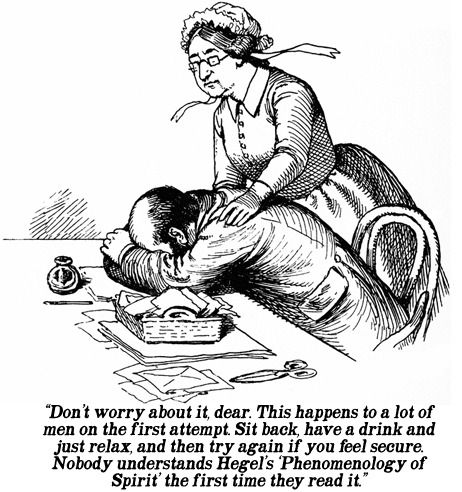B. Self-consciousness: IV. The truth of self-certainty
(104-138)
Wednesday, 19 November 2014 (notes by Marton Ribary)
Hegel introduces a number of social metaphors in section B
entitled “Self-consciousness”. The perplexing question is whether the social
turn of the Phenomenology is genuine. Does Hegel now embark on outlining
a social philosophy after the epistemological section A entitled
“Consciousness”? Or are his social metaphors merely means for speaking more
easily about the complex nature of perception?
Lord and bondsman:
Hegel introduces these concepts in §189 as two forms of
consciousness after “the dissolution of that simple unity” of pure
self-consciousness. One is “immediate” (or rather “existing” for the
German seiend), the other is “in the form of thinghood”; one is
“independent … whose essential nature is to be for itself”, the other is
“dependent … whose essential nature is simply to live or to be for another.”
“The former is lord, the other is bondsman.” The constellations of lord and
bondsman seem to replicate the opposition of subject and object at the level of
self-certainty, that of the being for itself and being for another at the level
of perception, and that of understanding and appearance at the level of
consciousness. The dialectical process has now moved onto the subsequent level
of self-consciousness which may or may not be inherently social.
Social reading vs phenomenological reading:
It is difficult to decide whether Hegel’s social terms function
as mere metaphors facilitating the reasoning about the complex, repeatedly
self-refuting, dialectical nature of perception, or whether Hegel thinks that
at the level of self-consciousness, phenomenological thinking necessarily turns
into social philosophy. Lord and bondsman can be understood as two sides of the
same perceiving process: the “lord” who realises that in perception he is
completely independent from all perceived objects, and the “bondsman” who finds
himself dependent and entangled with his own perceptions. According to this
reading, lord and bondsman are abstract configurations of the same perceiving
soul, and the social reading facilitates to enlarge the process.
The method á la Plato:
In Plato’s Republic political philosophy was merely a
means to talk about the soul as the macroscopic structure of society mirrors the
microscopic structure of the soul. Hegel seems to offer a similar approach. The
history of the World-Spirit is an enlarged version of the history of the
individual perceiving soul. The variations of social forms over historical time
mirror the variations of the stages the self-reflective soul goes through
during a lifetime.
Parallel histories of the individual soul and the World-Spirit:
The social and the phenomenological reading are not mutually
exclusive after all. At the level of self-consciousness, the self-reflective
“I” necessarily goes beyond and doubles itself. The outpouring of the “I”
results in two self-conscious entities which we may understand as two aspects of
the same perceiving subject (phenomenological reading) or two opposing social actors
(social reading). Hegel’s text is open to both readings, and they can be understood
as the microscopic and the macroscopic version of the same process – one as the
self-reflective thinking process of the individual soul, the other as the history
of the World-Spirit.

No comments:
Post a Comment